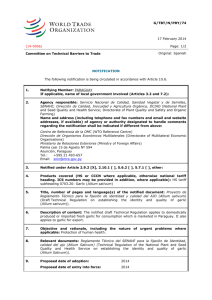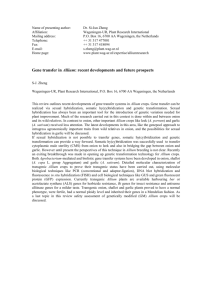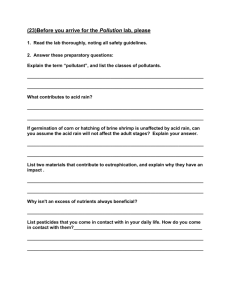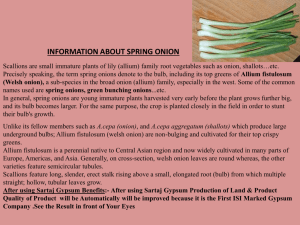Document 13310086
advertisement
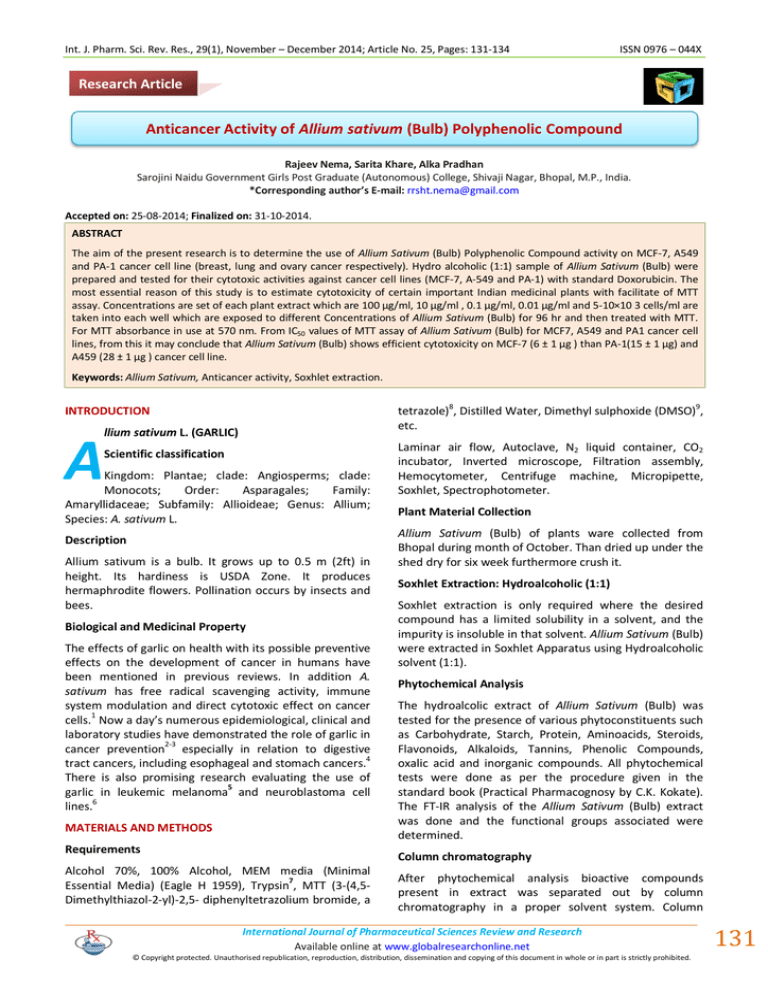
Int. J. Pharm. Sci. Rev. Res., 29(1), November – December 2014; Article No. 25, Pages: 131-134 ISSN 0976 – 044X Research Article Anticancer Activity of Allium sativum (Bulb) Polyphenolic Compound Rajeev Nema, Sarita Khare, Alka Pradhan Sarojini Naidu Government Girls Post Graduate (Autonomous) College, Shivaji Nagar, Bhopal, M.P., India. *Corresponding author’s E-mail: rrsht.nema@gmail.com Accepted on: 25-08-2014; Finalized on: 31-10-2014. ABSTRACT The aim of the present research is to determine the use of Allium Sativum (Bulb) Polyphenolic Compound activity on MCF-7, A549 and PA-1 cancer cell line (breast, lung and ovary cancer respectively). Hydro alcoholic (1:1) sample of Allium Sativum (Bulb) were prepared and tested for their cytotoxic activities against cancer cell lines (MCF-7, A-549 and PA-1) with standard Doxorubicin. The most essential reason of this study is to estimate cytotoxicity of certain important Indian medicinal plants with facilitate of MTT assay. Concentrations are set of each plant extract which are 100 µg/ml, 10 µg/ml , 0.1 µg/ml, 0.01 µg/ml and 5-10×10 3 cells/ml are taken into each well which are exposed to different Concentrations of Allium Sativum (Bulb) for 96 hr and then treated with MTT. For MTT absorbance in use at 570 nm. From IC50 values of MTT assay of Allium Sativum (Bulb) for MCF7, A549 and PA1 cancer cell lines, from this it may conclude that Allium Sativum (Bulb) shows efficient cytotoxicity on MCF-7 (6 ± 1 µg ) than PA-1(15 ± 1 µg) and A459 (28 ± 1 µg ) cancer cell line. Keywords: Allium Sativum, Anticancer activity, Soxhlet extraction. tetrazole)8, Distilled Water, Dimethyl sulphoxide (DMSO)9, etc. INTRODUCTION llium sativum L. (GARLIC) A Scientific classification Kingdom: Plantae; clade: Angiosperms; clade: Monocots; Order: Asparagales; Family: Amaryllidaceae; Subfamily: Allioideae; Genus: Allium; Species: A. sativum L. Description Allium sativum is a bulb. It grows up to 0.5 m (2ft) in height. Its hardiness is USDA Zone. It produces hermaphrodite flowers. Pollination occurs by insects and bees. Biological and Medicinal Property The effects of garlic on health with its possible preventive effects on the development of cancer in humans have been mentioned in previous reviews. In addition A. sativum has free radical scavenging activity, immune system modulation and direct cytotoxic effect on cancer cells.1 Now a day’s numerous epidemiological, clinical and laboratory studies have demonstrated the role of garlic in cancer prevention2-3 especially in relation to digestive tract cancers, including esophageal and stomach cancers.4 There is also promising research evaluating the use of garlic in leukemic melanoma5 and neuroblastoma cell 6 lines. MATERIALS AND METHODS Requirements Laminar air flow, Autoclave, N2 liquid container, CO2 incubator, Inverted microscope, Filtration assembly, Hemocytometer, Centrifuge machine, Micropipette, Soxhlet, Spectrophotometer. Plant Material Collection Allium Sativum (Bulb) of plants ware collected from Bhopal during month of October. Than dried up under the shed dry for six week furthermore crush it. Soxhlet Extraction: Hydroalcoholic (1:1) Soxhlet extraction is only required where the desired compound has a limited solubility in a solvent, and the impurity is insoluble in that solvent. Allium Sativum (Bulb) were extracted in Soxhlet Apparatus using Hydroalcoholic solvent (1:1). Phytochemical Analysis The hydroalcolic extract of Allium Sativum (Bulb) was tested for the presence of various phytoconstituents such as Carbohydrate, Starch, Protein, Aminoacids, Steroids, Flavonoids, Alkaloids, Tannins, Phenolic Compounds, oxalic acid and inorganic compounds. All phytochemical tests were done as per the procedure given in the standard book (Practical Pharmacognosy by C.K. Kokate). The FT-IR analysis of the Allium Sativum (Bulb) extract was done and the functional groups associated were determined. Column chromatography Alcohol 70%, 100% Alcohol, MEM media (Minimal 7 Essential Media) (Eagle H 1959), Trypsin , MTT (3-(4,5Dimethylthiazol-2-yl)-2,5- diphenyltetrazolium bromide, a After phytochemical analysis bioactive compounds present in extract was separated out by column chromatography in a proper solvent system. Column International Journal of Pharmaceutical Sciences Review and Research Available online at www.globalresearchonline.net © Copyright protected. Unauthorised republication, reproduction, distribution, dissemination and copying of this document in whole or in part is strictly prohibited. 131 © Copyright pro Int. J. Pharm. Sci. Rev. Res., 29(1), November – December 2014; Article No. 25, Pages: 131-134 chromatography was performed on a classic 20 cm long × 2 cm diameter glass column packed with 50 g Silica gel of 60-120 mesh size as stationary phase and crude drug were further subjected to column chromatography [CC] and eluted with specific solvent to obtain pure compounds. Silica gel for column chromatography was used as stationary phase. The flow rate used was 5 ml/min. Three and four elutes for each solvent were taken. ISSN 0976 – 044X colorimeter. Analyze data of test with standard drug and plot graph.14, 18 RESULTS AND DISCUSSION Phytochemical Evaluation: The results of preliminary phytochemical evaluation are summarized in Table 1. Table 1: The results of preliminary phytochemical evaluation Spectrophotometric Determination of Total Flavonoid Content (TFC) Natural product Test performed Result Carbohydrate Molish test +Ve Total flavonoid contents were measured by Aluminum chloride colorimetric assay. Hydroalcoholic extracts that has been adjusted to come under the linearity range and different dilution of standard solution of Quercetin (10100µg/ml) were added to 3ml of water. To the above mixture, 0.1ml of 5% C4H4O6KNa.4H2O (Potassium Sodium L-(+) - Tartrate Tetrahdrate) was added. After 5 minutes, 0.1ml of 10% AlCl3 was added and the total volume was made up to 3 ml with distilled water. It was left at room temperature for 30 min after which the absorbance of the reaction mixture was measured at 430nm with a single beam spectrophotometer (Systronic).10-11 Starch Iodine -Ve Protein Millions +Ve Amino acid Cysteine test +Ve Steroid Salkowski test +Ve Isolation of Human Cancer Cells Human cancer cells are isolated from the patients and characterized at cellular and molecular levels. Isolated cells are cultivated in specialized mediums and specialized incubators to provide them physiological conditions required for the growth.12-13 Cell Line The sub culturing of the primary culture gives rice to cell lines. The term continuous cell line implies the indefinite development of the cell in the successive sub culturing. On the other hand, finite cell lines symbolize the death of cell after several subcultures. The considered cell lines are MCF-7 14-15 (barest cancer), A-549 16 (lung cancer) and PA1 17(ovary cancer). Assay Performed MTT Assay Method Flavonoids +Ve Alkaloid Mayer’s test +Ve Tannic and phenolic compound %5 Fecl3 test +Ve Oxalic acid +Ve Inorganic acid Sulphate test +Ve Column chromatography Column chromatography of Allium Sativum (Bulb) was performed on a classic 20 cm long × 2 cm diameter glass column packed with 50 g Silica gel of 60-120 mesh size as stationary phase and Allium Sativum (Bulb) crude drug were further subjected to column chromatography [CC] and eluted with specific solvent chloroform methanol (1:2) to obtain pure compounds. FT-IR Spectral Analysis The FT-IR spectrum of the Allium Sativum (Bulb) leaves extract recorded the number of peaks lying between 3330.14 cm-1, 2943.57 cm-1, 2831.65 cm-1, 17.64 cm-1, 1453.30cm-1,1453.30 cm-1,1239.30cm-1,1111.50 m1,1021.76 cm- 1,751.81 cm-1, and 662.91 cm-1 respectively. This finding will help in further research in the investigation of medicinally active chemical compounds present in Allium Sativum (Bulb). Quantification Laminar air flow was prepared. Dilutions of concentration 100 µg/ml, 10 µg/ml, 1 µg/ml, 0.1 µg/ml, 0.01 µg/ml from stock solution (test drug +DMSO) having concentration 10mg/ml is done. Then normal count on haemocytometer before seeding the cells in plate was done. 10µl from each conc. in 4wells i.e. 20 wells for one drug was added. Plate contained 5-10×10 3 cells/ml into each well of 96well culture plate. The cells were incubated for 96 hr in CO2 incubator. After it cells are incubated with basal medium containing 0.5 mg/ml MTT in CO2 incubator at 37°C for appropriate duration of time. The medium is aspirated, and the formazan product is solubilized with dimethyl sulfoxide (DMSO). Absorbance at 570 nm is measured for each well using a microplate reader on Current study revealed the flavonoid contents of Allium Sativum (Bulb). (Quercetin standard plot: y =0.0966x, 19 R2=0.9878). On the basis that calibration curve was plotted by preparing the Quercetin solutions at concentrations 12.5 mg/ml-1. Total flavonoid content of the extracts was expressed as percentage of flavonoid in plant extract 4.35 µ.g./ml equivalents per dry weight of sample and take notice of y=0.002x+0.0148, R2 =0.993. Cell Line MCF-7 A-549 PA1 Sample Code AS AS AS IC50 (mg/ml) 6±1 20±1 11±1 International Journal of Pharmaceutical Sciences Review and Research Available online at www.globalresearchonline.net © Copyright protected. Unauthorised republication, reproduction, distribution, dissemination and copying of this document in whole or in part is strictly prohibited. 132 © Copyright pro Int. J. Pharm. Sci. Rev. Res., 29(1), November – December 2014; Article No. 25, Pages: 131-134 MTT Assay Result ISSN 0976 – 044X DISCUSSION Figure 1: MCF7 Cells were treated with hydro alcoholics extract of Allium Sativum dissolved in DMSO at 0.01, 0.1, 1, 10, 100 conc. Cells were subjected to MTT within 1 hr24 hr. Response of MCF7 Cell to Allium Sativum For % Inhibition on Y-axis and Concentration on X-axis. Allium Sativum (Bulb) extracts was investigated. The invitro cytotoxic potentiality was investigated as the ability of Allium Sativum (Bulb) extracts to inhibit tumour cell line growth. With this investigation we had also focused on angiogenesis. The studied cell lines are MCF7, A549 and PA1. After exposure of cells to Allium Sativum (Bulb) extract cell line were treated with MTT Dye which results into the live cells convert the MTT to purpled colour formazan crystals, which are soluble in Dimethyl sulphoxide (DMSO). After solubilization of crystals then absorption is taken on spectrophotometer at 570 nm. With respect to readings the graphs were plotted for % inhibition on Y-axis and Conc. of drug on X-axis. The readings were directly converted into percentage. from this it may conclude that Allium Sativum (Bulb) shows efficient cytotoxicity on MCF-7 (6 ± 1 µg ) than PA-1(15 ± 1 µg) and A459 (28 ± 1 µg ) cancer cell line where Standard drug was used for IC50 of Doxorubicin MCF-7 500nm, A549- 550nm, PA-1- 580nm. CONCLUSION Figure 2: A549 Cells were treated with hydro alcoholics extract of Allium Sativum dissolved in DMSO at 0.01, 0.1, 1, 10, 100 conc. Cells were subjected to MTT within 1 hr24 hr. Response of A549 Cell Allium Sativum For % Inhibition on Y-axis and Concentration on X-axis. In the present time herbal products are considered to be symbols of protection in comparison to the synthetic product that are regarded as unsafe to human life and environment. Although herbs had been priced for their medicinal importance. But now everyday phytochemical and pharmacological studies are conducted on different parts of plants. More research can be done to investigate the unknown and unexplored potential of these plants. Further analysis of these plants (active compounds) can be carried out by way of making use of different analytical methods such as HPTLC, HPLC, NMR and UV spectrophotometer analysis. Acknowledgement: The authors express gratitude Amit Deshpande Deshpande Lab., and Pvt., Ltd., Bhopal, MP. India. REFERENCES Figure 3: PA1 Cells were treated with hydro alcoholics extract of Allium Sativum dissolved in DMSO at 0.01, 0.1, 1, 10, 100 conc. Cells were subjected to MTT within 1 hr24 hr. Response of PA1 Cell to Allium Sativum For % Inhibition on Y-axis and Concentration on X-axis. 1. Abdullah TH, Kandil O, Elkadi A, Carter J, Garlic revisited: therapeutic for the major diseases of our times, J. Natl Med. Assoc., 80, 1988, 439–445. 2. Fleischauer AT, Arab L, Garlic and cancer: a critical review of the epi demiologic literature, J. Nutr Suppl., 3, 2001, 1032S. 3. Galeone C, Pelucchi C, Levi F, Negri E, Franceschi S, Talamini R, Giacosa A, La Vecchia C, Onion and garlic use and human cancer, Am J Clin Nutr, 84(5), 2006, 1027–32. 4. Berspalov VG, Shcherbakov AM, Kalinovskii VP, Novik VI, Chepik OF, Aleksandrov VA, Sobenin IA, Orekhov AN, Study of the antioxidant drug "Karinat" in patients with chronic atrophic gastritis Vopr Onkol, 50(1), 2004, 81–85. 5. Taylor P, Noriega R, Farah C, Abad MJ, Arsenak M, Apitz R, Ajoene inhibits both primary tumor growth and metastasis of B16/BL6 melanoma cells in C57BL/6 mice, Cancer Letters, 239(2), 2006, 298–304. International Journal of Pharmaceutical Sciences Review and Research Available online at www.globalresearchonline.net © Copyright protected. Unauthorised republication, reproduction, distribution, dissemination and copying of this document in whole or in part is strictly prohibited. 133 © Copyright pro Int. J. Pharm. Sci. Rev. Res., 29(1), November – December 2014; Article No. 25, Pages: 131-134 6. Karmakar S, Banik NL, Patel SJ, Ray SK, Garlic compounds induced calpain and intrinsic caspase cascade for apoptosis in human malignant neuroblastoma SHSY5Y cells, Apoptosis, 2007. 7. Cole RJ, Paul J, The effects of erythropoietin on haem synthesis in mouse yolk sac and cultured foetal liver cells, J. Embryol. Exp. Morphol., 15, 1966, 245-260. 8. Mosmann T, Rapid colorimetric assay for cellular growth and survival: Application to proliferation and cytototoxicity assays, J. Immunol. Methods., 65, 1983, 55-63. 9. Lovelock JE, Bishop MH, Prevention of freezing damage to living cells by dimethyl sulphoxide, Nature, 183, 1959, 1394-1395. 10. Garrat DC, The Quantitative analysis of Drugs, Chapman and Hall Ltd., Japan, 3, 1964, 456-458. 11. McDonald S, Prenzler PD, Antolovich M, Robards K, Phenolic content and antioxidant activity of olive extracts, Food Chemistry, 73, 2001, 73 – 84. 12. Satyanarayan U, Biotechnology animal cell culture, facilities and application, 2008, 407. ISSN 0976 – 044X 14. Soule HD, Vasquez J, Long A, Albert S, Brennan M, A human cell line from a pleural effusion derived from a breast carcinoma, J Nat l. Cancer Inst., 51, 1973, 1409-1416. 15. Giard DJ, Aaroson SA, Todaro GJ, Arnstein P, Kersey JH, Dosik K, Parks WP, In vitro cultivation of human tumors: Establishment of cell lines derived from a series of solid tumors, J. Natl. Cancer Inst., 51, 1972, 1417. 16. Gualtieri M, Mantecca P, CorvaJa V, Longhin E, Perrone Mg, Bolzacchini E, Camatini M, Winter, Fine particulate matter from Milan induces morphological and functional alterations in human pulmonary epithelial cells (A549), Toxicol Lett, 2, 1999, 188(1), 52–62. 17. Goff BA, Mandel L, Muntz HG, Melancon CH, Ovarian carcinoma diagnosis, Cancer, 98, 2000, 2068-75. 18. Shapiro HM, Practical Flow Cytometry, 2nd ed., John Wiley & Sons, New York, 1988, 129. 19. Elija K, Vaishali BA, Manik MK, Deshpande NR, Kashalkar RV, Spectroscopic determination of total phenol and flavonoid contents of Ipomoea carnea, Intern. J. Chem.Tech. Res., 2(3), 2010, 1701. 13. Fershney, Culture of animal cells manual of basic technique, 4th edition, 2000, 184- 188, 299-301, 182-183. Source of Support: Nil, Conflict of Interest: None. International Journal of Pharmaceutical Sciences Review and Research Available online at www.globalresearchonline.net © Copyright protected. Unauthorised republication, reproduction, distribution, dissemination and copying of this document in whole or in part is strictly prohibited. 134 © Copyright pro
